Review for Patlabor - The Mobile Police TV Series Collection 1
Introduction
I always do these things backwards. My first encounter with the Patlabor universe was with the two spin-off movies made by Mamoru Oshii, courtesy of some rather delectable special editions from Beez. I wasn’t fond of giant robots to begin with, but I did think that Patlabors were giant robots that I could appreciate, coming from a comparatively realistic perspective. I did consider getting the series back then, but it was a US Central Park Media release over countless discs. It was only when MVM released the 2 OVA series that I was reminded of the show, but they didn’t do as well as could be hoped for MVM, not well enough to warrant releasing the TV series. So once again it was time to import. By this time, Sentai Filmworks had licensed the show, re-mastered for Blu-ray release. Alas, that Blu-ray is locked to region A, so I had to settle for DVD only, and comparatively inexpensively so from Madman Entertainment in Australia, who released the 47 episode run in two collections as opposed to Sentai’s four.
So I’m watching the TV series last of all, after the movies and after the second OVA series that was made to have a little more fun in that universe and tie up a couple of loose ends. I had thought that the TV show would pick up where the first OVA series left off, continuing the storyline the way that Your Under Arrest did after its first four episode OVA, but instead it turns out that the Patlabor television series starts all over again, with a different tale as to how Noa Izumi was recruited into SV2.
In an alternate Tokyo (it was the future Tokyo when this show was originally made though), all of the city's energy is invested in Project Babylon, the creation of artificial islands and dams, and the reclamation of thousands of square hectares of habitable land area, to allow for the expansion of the city. Such a monumental undertaking would have been impossible, were it not for the Labors. Giant humanoid robots now do much of the heavy lifting in the city, piloted by trained professionals now doing the work of what would have taken many times that number in manpower alone. The output by these powerful machines ensures that Project Babylon runs to schedule.
Of course not every Labor is used responsibly; some people use them for criminal activities, which is where the Patrol Labors come in, the so-called Patlabors. The Special Vehicle Section of the Tokyo Police force come equipped with Labors of their own, with which they detect and combat Labor crime in the city. The Division 2 of the Special Vehicles Section 2 is the unconventional department, whose methods leave much to be desired, and is seen as a dumping ground for those officers who don't quite fit in elsewhere. As the series begins, the Division 2 is making do with old equipment and a whole lot of luck to achieve their missions. Things are about to change though, with the arrival of the new patrol labors, the Model 98-AV Ingram. They’re also due a new recruit, one total robot geek named Noa Izumi, who has already picked out a name for her Labor. She’s about to have a rude introduction into the laid back attitude of Captain Goto’s Division 2. That attitude will be even more grating for the NYPD’s finest, Kanuka Clancy, who is transferring in for six months of advanced training. But as the prevalence of Labor crime increases, and terrorism continues to afflict the city, things are about to get more serious for SV2.
The first 24 episodes are presented across four discs from Madman Entertainment.
Disc 1
1. Ingram Activated
2. Kanuka has Come
3. This is SV2
4. Head to the Mountain of Mystery!
5. Labor X-10 Out of Control!
6. The Tower: S.O.S.
Disc 2
7. Glorious Type 97 Modified
8. Elusive Green
9. Red Labor Landing
10. Eve’s Trap
11. Eve’s Terror
12. Ota’s One Troubled Afternoon
Disc 3
13. Gently, Your Highness!
14. You Win!
15. The Whale That Sang a Song
16. The Unit Crosses the Sea
17. Target: Captain Goto
18. I Love Noa-Senpai
Disc 4
19. Shadow in Geo-Front
20. Movement in the Dark
21. Phantom Again
22. Labor and Flower
23. Kanuka’s Report
24. Farewell, Kanuka
Picture
For its re-release Patlabor got a full HD upgrade, understandable given its 1989 vintage and cel animation on film. It’s been cleaned up and restored for Blu-ray in Japan and the US courtesy of Sentai, and it’s those HD masters that Madman have used to create their PAL DVDs, making use of the full 576 lines of resolution available to them. Patlabor’s transfer is fantastic, clear and sharp throughout, with no so signs of age or print damage, and little in the way of compression or banding. You might see some aliasing if you freeze frame, but there’s none apparent during normal playback. It also scales up a treat to an HD panel, so much so that there are moments that I forget that I’m watching a DVD at all, and start thinking it’s a Blu-ray. Of course with this being a PAL release, there is 4% speed-up, but it looks great.
What also impresses is the quality of the animation. Mecha animation on a weekly schedule and budget is a tough enough ask, but Patlabor had to be done with cels and paint, no convenience of computer animation here (except for the prologue to the second half of the collection). It’s hard to imagine, but Patlabor came just ten years after Mobile Suit Gundam, but its visuals look twenty, or even thirty years more advanced. Great direction and careful planning means that you’ll hardly notice the usual shortcuts that animators used to get their work done on schedule, the pans over static images, the zooms, the stock footage and the like. It isn’t as fluid and energetic as the movies or indeed the OVAs, but this is good quality animation, with comparatively realistic and believable character designs, a delightful eye to detail when it comes to mecha and technology and, what was then, a near future world that is recognisably close to our own, but with enough futuristic touches to give it an edge of fantasy.
Sound
You have the choice between DD 2.0 English and Japanese with optional translated subtitles and a signs only track. This may be a vintage show, but it has a decent amount of sound design to it, bringing the Labors to life, with suitable presence. The dialogue is clear throughout, the subtitles are accurately timed and free of typos, the action comes across well, and the show’s music drives the stories perfectly. It’s a nice, entertaining audio experience... in Japanese. As for the English dub... Yeesh! This one comes from the days of Central Park Media and it is excruciatingly bad. Better to forget that the dub even exists on these discs than to risk listening to it and having it put you off an otherwise decent show.
Extras
Patlabor’s 4 DVD discs are presented in an Amaray case, with some nice inner sleeve art. There are two discs on either face of the case, and two discs either side of a central hinged panel.
The discs present their content with static menus. Unlike the usual Sentai discs transitioned to Australia, there are no translated credit reels following the episodes.
The only extras are on disc 4, and comprise trailers for Wolf Children, Toriko Collection 1, Sword Art Online Volume 1, Patlabor OVAs Season 1, and Fairy Tail Collection 5 following an Australian anti-piracy thank you.
Conclusion
Patlabor’s TV series might start over again, ditching the story that developed in the first OVA series, but it still feels like the same show, with the same characters, the same storytelling style, the same feel to it. That’s all to the good, as I really enjoyed that first OVA series, and I did hope that the TV series would live up to it. This is the giant robot show to watch if you do not like giant robots. For one thing, the robots aren’t characters in this show (except for Noa Izumi, who simply has to anthropomorphise her Alphonse); they’re just machines, tools to assist in the construction industry. The real joy in the show is in watching the characters and how they interact, and you get the feeling that the character dynamics would work even if the robots weren’t part of the story.
The difference between the series and the OVA is in how it starts. In the TV series, the SV2 unit is fully established and working at the beginning, with the major development the arrival of the new Ingram Labors to replace the older, less capable models. With the new robots comes one new recruit, Noa Izumi, something of a Labor otaku. The second episode sees the arrival of Kanuka Clancy, an NYPD officer on an exchange programme to learn about Japanese methods of Labor policing. Characters like Asuma, Shinshi, Yamazaki and Ota are already established and in place at the start of the show.
It also quickly becomes clear that Special Vehicles Division 2 is the maverick unit of the police force, that its captain Goto has been assigned to the boonies almost as a punishment for not conforming to standard methods of policing. Certainly his relaxed attitude and whimsical approach to his job comes across clearly, and that attitude rubs off on his staff who are quirky to say the least. I doubt that Noa’s passion for her Labor would be tolerated in any other department. Asuma’s there trying to get away from his industrialist father (who owns the company that manufactures the Ingram Labors), Yamazaki is surprisingly kind hearted and soft for a man of his stature, Shinshi is a family man, while Ota likes shooting things, no he loves shooting things. And this man is a Labor pilot with a giant robot’s hand cannon in a holster. It’s into this environment that Kanuka Clancy enters, expecting professionalism and attention to detail and finding something other than that. This 24 episode stretch covers her six months in SV2, Division 2, and in some ways she serves as our eyes into this unconventional police force. Of course as a contrast there is Division 1, and Goto shares an office with their Captain Shinobu. But most of the contrast comes from the conversations that the two have, and we rarely get to see Division 1 in action.
We do get to see a lot of Division 2 in action, and it quickly becomes clear why they are tolerated, even as mavericks. They always tend to get results, even if they leave a trail of mayhem in the process. This happens through the show’s episodic structure, with each new episode offering a different story. Just like the OVAs, some are better than others, and I have to admit that the ‘monster’ episodes are the ones that I find the weakest, just like the sea monster episode in the OVAs. In this one there’s another genetically engineered beast that’s rampaging in a forest, as well as a ‘Nessie’ in caverns underneath the city. For me they’re just out of place in a show that has a more consistent and realistic worldview than normal. But the rest of the episodes are great entertainment, mixing Labor crime stories with terrorism tales, and tales of the SV2 on their off-days.
If there is an ongoing arc in the show, it becomes apparent in a couple of two part episodes, Eve’s Trap and Eve’s Terror, as well as Movement in the Dark and Phantom Again. We get introduced to the Schaft company, and the shady figure of Kurosaki, a man who uses illicit means to develop, create and test his military spec Labors. He’s not beyond using the military and the police Labor forces to test his designs against, and then when he sees Noa’s Ingram at work pulling off moves that Labors shouldn’t be able to, he’s eager to indulge in a little espionage. This story thread begins pretty early here, but to see it concluded, you’ll need to watch the second OVA series, set after the end of the TV series proper.
I really do enjoy Patlabor. It’s an action show that doesn’t take its drama all too seriously, choosing never to get dark and serious. In that respect it’s a lot like the US eighties action shows that I used to watch, shows like Magnum or Miami Vice, where the action could be intense, the story of the week could be dark or light, but the point was that the characters were well written, and they were fun. Another thing is that for an anime show, these characters sound real, they sound human. Watch any modern anime, and you’ll probably enjoy it, engage with the characters, be entertained by the story. But imagine a real life human speaking in an anime character voice. It just doesn’t fit, does it? That’s especially true for the moeblob infantilised female characters that are fashionable at the minute. The characters in Patlabor sound human. You can imagine real people talking that way (well maybe not Ota during one of his gun loving rants), but generally they feel real, and that and the scripts make Patlabor work for broad audiences, not just specialised niches. This one is definitely worth getting, and definitely worth someone licensing for UK release.

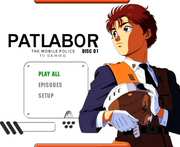











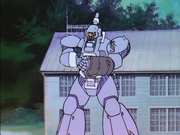


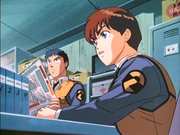






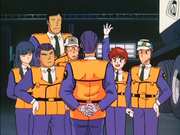



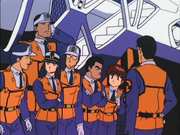








































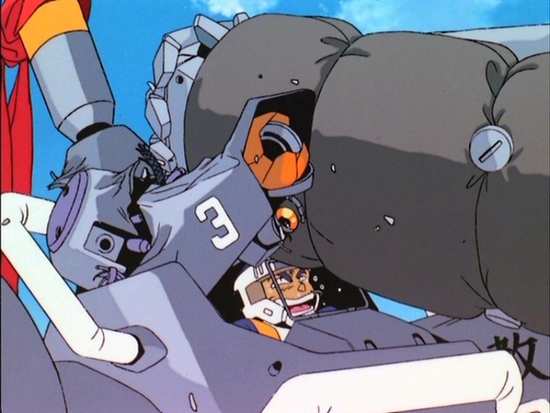










Your Opinions and Comments
Be the first to post a comment!